
To begin, I’ll quote myself from the ForgottenBook…
Stapleton and Clifton are two adjacent neighborhoods on Staten Island’s northeast coast along Upper New York Bay. The Vanderbilt family held much land here in the early 19th century; in 1836 Minthorne Tompkins (the son of Vice President Daniel Tompkins) and merchant William Staples established a ferry to Manhattan and founded the village at Bay and Water Streets. German immigrants built numerous breweries in the area in the 1800s including Bachmann, Bechtel, and Piels, whose brewery was in business on Staten Island until 1963.
Among the most notable and strangest aspects of Stapleton’s history was the presence of the National Football League, which fielded a team known as the Staten Island Stapletons here from 1929 through 1932. The Stapes were a semipro team founded by restaurateur Dan Blaine in 1915, who played halfback for the team until 1924. Over the following couple of seasons, the Stapes would play exhibitions against pro teams from the NFL and the 1920s version of the American Football League, and after they rolled up a 10-1-1 record in 1928, including a 3-1 record against NFL squads, the Stapes joined the NFL the next season. playing in tiny Thompson’s Stadium on Tompkins Avenue, a site now occupied by Stapleton Housing. Led by halfback Ken Strong, a New York University graduate, the Stapletons compiled a 14-22-9 record against NFL competition in four years. The Stapes played an exhibition schedule in 1933, with some games against NFL teams, before Blaine folded the team and Strong joined the New York Giants.
In addition, the famed rap group Wu-Tang Clan, who have rung up sales in the millions since the early 1990s, were founded in Stapleton Houses.
Stapleton is by turns picturesque and forbidding. The main business section along Bay Street can be sketchy, but Tappen Park, which contains the former town hall of Edgewater (the Staten Island town that contained Stapleton) is surrounded by classic architecture, such as the Staten Island Savings Bank at Water and Beech Streets. Stapleton Heights, along St. Paul’s and Marion Avenues, is a NYC Landmarked District encompassing a number of beautiful Queen Anne-style residences; a Forgotten NY tour visited one such home back in 2014.
It was scouting a Forgotten NY tour in Fort Wadsworth, Clifton and Rosebank that brought me to Harrison Street in Stapleton in 2019. I decided to take a walk toward the ferry along Tompkins Avenue, one of the main drags; it was named for Vice President Daniel Tompkins, who developed the neighborhood of Tompkinsville in the 1810s, naming several streets such as Minthorne, Hannah and Arietta (now part of Victory Boulevard) for his children.

Bayley Seton Hospital at once presents one of NYC’s greatest historical opportunites and one of its greatest wastes, as most of its campus is disused at present.
When the Sisters of Charity acquired the hospital in 1980 its name became Bayley Seton, after Richard Bayley, the head of the former Tompkinsville Quarantine Hospital and his daughter, Elizabeth Ann Seton (1774-1821), the founder of the order and the first canonized American-born saint (in 1975). Born into the Anglican Church, Elizabeth was a convert to Catholicism after the death of her husband William Seton. Her grandfather, Rev. Richard Charleton, was a rector of St. Andrew’s Church in Richmondtown and is buried in its churchyard.
After 2000 Bayley Seton Hospital fell on hard times after the Sisters of Charity turned over operations to the Vincentians, who faced financial troubles. Subsequently in 2009 the Salvation Army acquired the hospital, closing 8 of its 12 campus buildings; the eight stand abandoned and subject to predation by the elements, similar to Seaview Hospital and the Farm Colony in mid-island.
I acquired more photos of the campus, but did not see a very small “no trespassing” sign at the Tompkins Avenue driveway. After about 5 minutes I was accosted by a peevish security guard who drove up and ordered my vacation of the property. I did manage to get him to accept my card, but promised him I wouldn’t publish photos of the grounds, and I’m as good as my word.
I was mystified about the top secrecy. There may be a variety of reasons. A visit to the campus by SiLive.com to the abandoned buildings revealed severely dangerous conditions: I was aware of these, and had no intention of spelunking whatever abandoned buildings remained by 2019. The campus remains home to the Richmond Center for Rehabilitation and Nursing, Centers Adult Day Care at Richmond, and New York Foundling Staten Island Community Services. The main building still hosts Centers Care Solutions and Bayley Seton PREP, supporting people seeking detoxification, addiction treatment and crisis stabilization. In addition, the abandoned buildings have been used by TV shows such as Gotham. I suspect the angry guard may have been associated with a production crew.

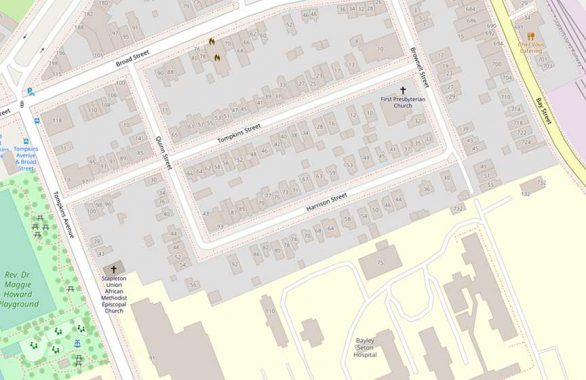
Thwarted at Bayley Seton I continued up Tompkins Avenue and then down Tompkins Street (yes, Tompkins Street meets Tompkins Avenue at the outskirts of Tompkinsville) and into a nook that has actually been called The Nook. A treasure trove of 19th Century architecture can be found on Harrison Street, named for Dr. John Talbot Harrison, one-term State Assemblyman and Chief Health Officer of the Quarantine Station in Tompkinsville.
As you will see I find it amazing that the street has not been given a neighborhood designation by the Landmarks Preservation Commission; any building on Harrison Street, except for one landmarked house, can be torn down or severely altered. A sure sign of a historic neighborhood is the presence of bluestone sidewalks, as they were the primary means of paving sidewalks, where they existed, before concrete took over as the primary method.
The most prominent corner building at Harrison and Quinn Streets is #93-95 Harrison Street, and you have to angle around the telephone wires to get a decent picture. The 1880s were a great decade for architecture (in my opinion) and this brick multifamily building arrived in 1883, designed by Philip Wolff, who also laid the bluestone sidewalks.
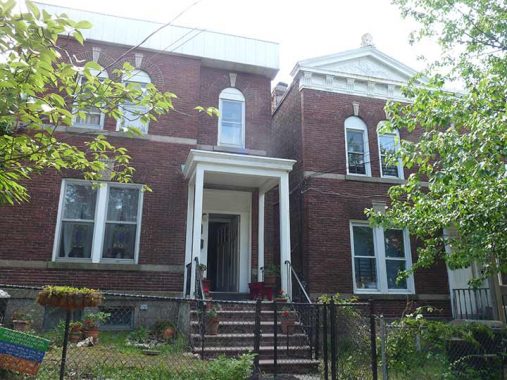
Facing Harrison Street at #48-52 Quinn Street are a trio of complementary brick faced dwellings. The Colonial Revival buildings were also constructed by Wolff.
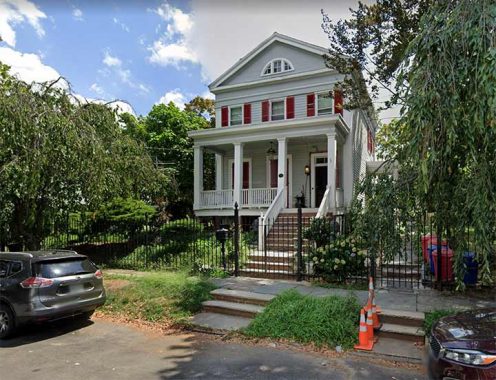
#92 Harrison Street is the only building on Harrison Street under Landmarks Preservation Commission protection, and it’s a Greek Revival beauty. It was built around 1840 give or take a year for Susan M. Tompkins Smith, a daughter of Daniel Tompkins.
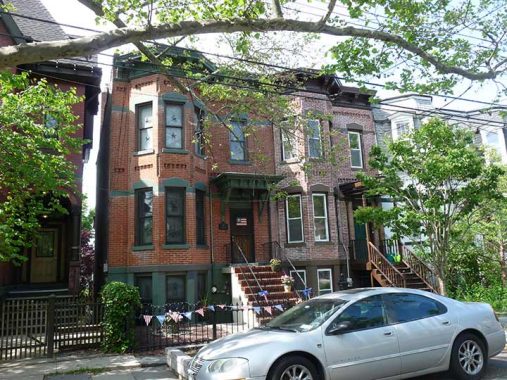
#83 and 85 Harrison are attached houses built in 1877 for Samuel and Isabella Cassidy, owners of a dry goods store on Bay Street, and remained in the family for over 60 years. There are prominent bay windows that allow residents to see the street from three separate angles.
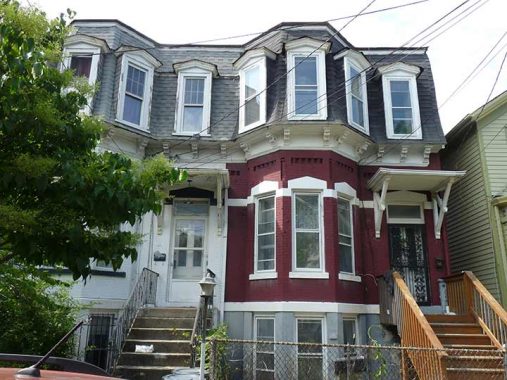
Even more prominent bays can be found on #79 and 81 Harrison, also from 1877, and include some of the lengthiest dormer windows you’ll see anywhere.
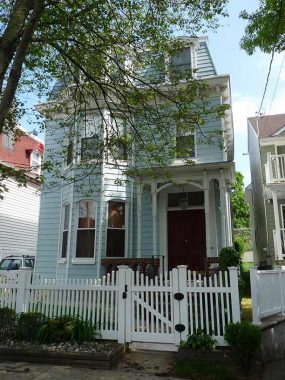
#74 Harrison Street, a narrow building with a French Second Empire style slanted, or mansard, roof, was built for William R. Eddy (the Eddy family was prominent in Staten Island, with an Eddy Street in Grymes Hill) and was later owned by the publisher of local newspaper, The Staten Islander, Michael Kane.
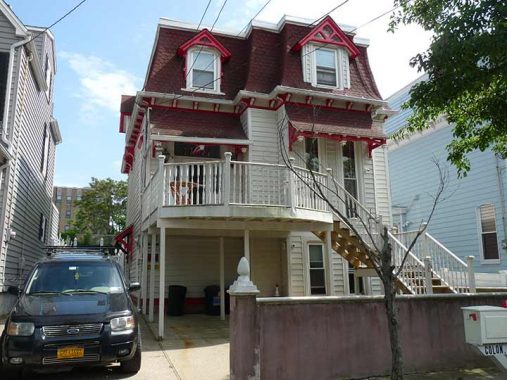
Next door, #70 Harrison Street was built in 1868. For many years it was owned by Michael S. Tynan, a coal and wood dealer who also owned the entertainment center Tynan’s Hall and served as president of the village of Edgewater (which included Stapleton) from 1882-1883. The bottom floors have been heavily altered but original details can still be seen at the roofline.

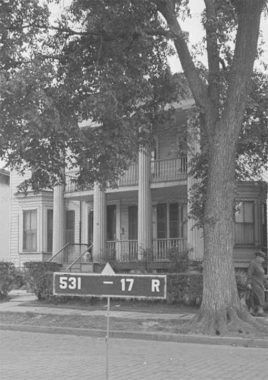
One of the reasons Harrison Street hasn’t been given an overall landmarks designation is that many of the houses have undergone extensive changes from when they were built. #64 Harrison is one of the older buildings on the block, built in 1848, but its original thick columns have been replaced, the second story porch removed, and the exterior covered with siding (see the 1940 photo for comparison). It was constructed for for Edward and Amelia Blake, owners of a general store in Clifton.

#63 Harrison was also built by William R. Eddy. Its similar neighbors, #59 and 67, were built by local carpenters Adrian R. and Peter Post.
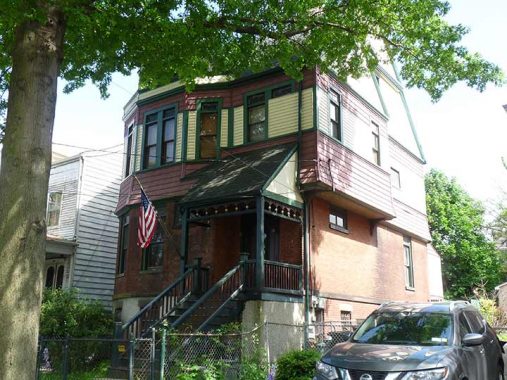
I always liked the buff and brown color combination, seen here at #54 Harrison Street. Many of its original details survive especially at the entrance and roofline.
The Queen Anne/Shingle Style house at number 54 was built by carpenter-builder James R. Robinson, and has two stories plus a raised basement and attic. Each level is made of or faced with a different material, giving the house a rich polychromatic texture. [Six To Celebrate]
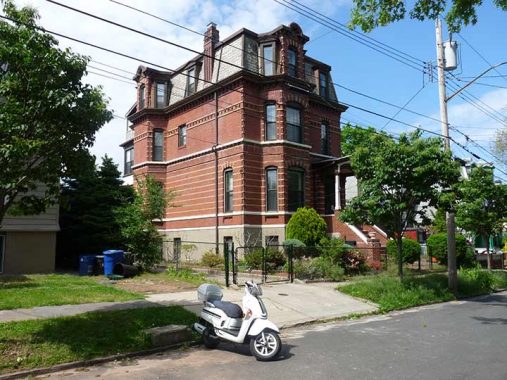
#53 Harrison Street , one of the tallest on the street and featuring elaborate European-inspired polychrome brickwork, was constructed in 1880 for the brewmaster of the local Rubsam & Horhmann Brewery, Henry Warth. The R&H Brewery was located in Stapleton from 1870 to 1953 (distributed as R&H since 1888), when it was purchased by Piels, which was also brewed in Stapleton. Piels ended its Staten Island operations in 1963, but the R&H brand was revived in 2019 by Brian Quinn.
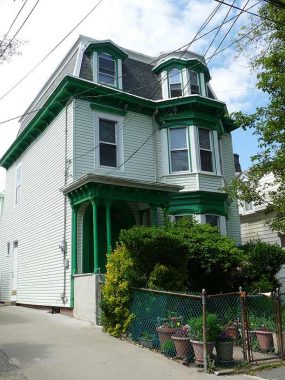
In handsome green and aqua, #45 was constructed in 1875 by William Eddy’s brother James; the two brothers and their father Cornelius operated a lumber yard in Stapleton.
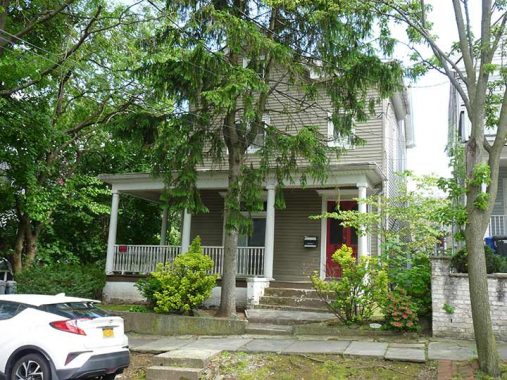
#44 Harrison Street was the home of architects and developers Adrian R. and Peter Post and was constructed in 1858. Its porch with narrow Ionic columns is the original.

The Second Empire-styled #36 Harrison Street was constructed by lumber patriarch Cornelius Eddy in 1875.
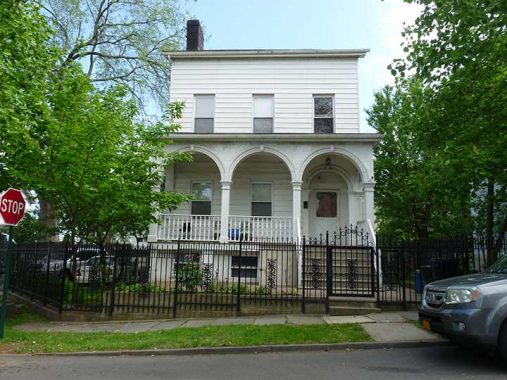
#30 Harrison Street, at the corner of Brownell, featuring an arcade porch, was also built by a lumber merchant, Elwood Taylor.
For a short two-block street, Brownell Street boasts two Protestant churches, facing each other across Tompkins Street, First Presbyterian (which appears to be a private home converted to a church) and the Temple of Restoration with its stepped gables.
I noticed the two metal street signs at #26 Broad Street, corner of Brownell. To satisfy curiosity I looked up the building in the 1940 Municipal Archives and found them absent then. So, the signs aren’t as old as they appear.
I had walked from Lily Pond and Major Avenues through Fort Wadsworth, Rosebank, Clifton and Stapleton and before getting the bus back to the ferry, time to show some of the artwork at Bay and Broad Streets, some of which was commissioned by an Indian restaurant on the corner.
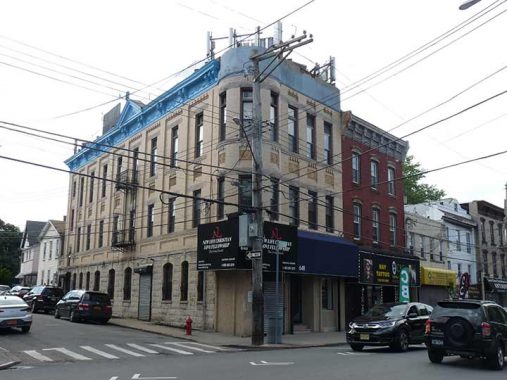
A handsome apartment building, probably dating from the 1910s, on Bay and Thompson Streets, has been somewhat compromised by the presence of cell phone relays.
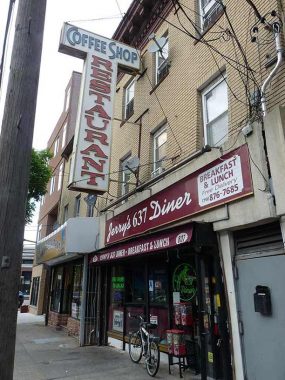
Johnny’s 637 Diner, on Bay Street south of Canal Street at Teppen Park. It’s open from 7:30AM to 3 PM. Notable for its sidewalk vertical sign, which has been there since at least the 1980s and probably a lot longer than that.
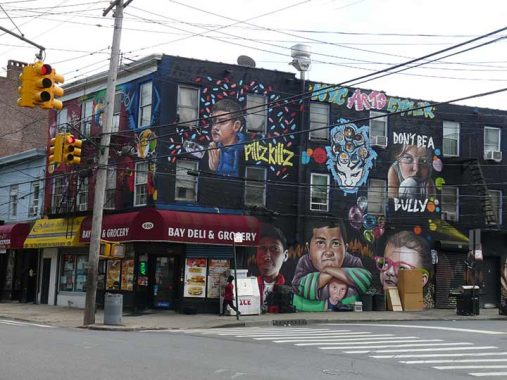
I’m sure to return to the Bay Street route in Tompkinsville, Stapleton, Clifton and Rosebank–I have never devoted an entire page to Bay Street…but probably not because of what happened to the building at Bay and Broad Streets where you find Bay Deli and Grocery.
As always, “comment…as you see fit.” I earn a small payment when you click on any ad on the site.
11/27/22


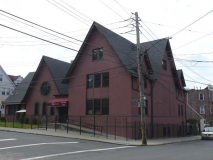
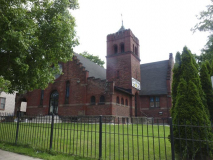


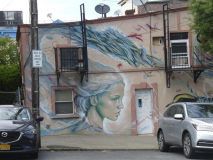



10 comments
He might have gotten a whole ‘hood named after him but Daniel Tompkins was in other respects an unlucky dude. Due at least in part to the depredations of Demon Rum he was Gathered to His Ancestors at age 50, the shortest life span of any vice president.
I didnt know Piels was made in Staten Island.It was a good cheap beer.Remember them?
They came out with the wide mouth bottle so you could cram more beer down your throat.
That way you could get drunk faster.
The two cartoon characters Harry and Bert Piel were amusing.They had a rifle range down
in the basement of the brewery per the old German tradition of shooting clubs but Bert
could be dangerous around firearms.
Peis bought the R&H Brewery which was original to S.I. Within a couple of years it was shut down.
Burt & Harry Piel at work:
https://www.bing.com/videos/search?q=Burt+%26+Harry+Piels&view=detail&mid=267212B2AC4EDD86A821267212B2AC4EDD86A821&FORM=VIRE
Voiced by Bob Elliot (father of Chris Elliot) & Ray Goulding (they wrote the scripts, too); they were a popular comedy act for decades (when members of the general public were allowed to have a sense of humor). I wish I could find Piel’s Beer so I could toast the memory of Bob & Ray, a great comedy duo.
I’m not a NYer, I’m from Arkansas. But I married a guy from Port Washington. I absolutely love seeng the classic architecture in the NYC area. I’m so glad that not everything has been torn down and replaced in the name of capitalism! And thank you so much for all the background history on so many sites that aren’t well known.
I particularly enjoy articles like this one that highlight old neighborhoods that are still fairly untouched.
Keep it up!
On the Gotham show, Bayley Seton stood in for the Arkham Hospital for the Criminally Insane, with the help of some CGI to make it look a bit more forbidding.
Piels was brewed in East New York, Brooklyn, on Liberty Avenue close to Broadway Junction, for most of its years. It acquired the R&H label and for a short time brewed that in S.I. but shut down in the early 1960’s. The East NY plant closed in the early 1970’s.
As Jimmy Breslin opined in an old TV ad, “It’s a good drinkin’ beer.”
Trommer’s also had brewery on Broadway Jct. One in the same ?
The apartment building at Bay and Thompson Streets was featured in the film “School of Rock” with Jack Black. It served as the exterior of Jack’s music school.
I worked at Bayley Seton and St. Vincents back when they were part of Sisters of Charity. One of the outer buildings at the Bayley Seton campus was once a Vanderbilt mansion…from its front veranda (crumbling even when I worked there) there must have been an amazing view of NY Bay back in the day. When I was there, the building served a variety of medical functions, but up in the off-limits attic could be found many treasures, including an actual iron lung…so sad what has happened to the place.